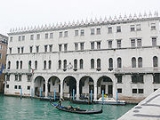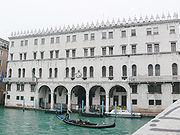
Fondaco dei Tedeschi
Encyclopedia

Venetian language
Venetian or Venetan is a Romance language spoken as a native language by over two million people, mostly in the Veneto region of Italy, where of five million inhabitants almost all can understand it. It is sometimes spoken and often well understood outside Veneto, in Trentino, Friuli, Venezia...
: Fontego dei Tedeschi) is a historic building in Venice
Venice
Venice is a city in northern Italy which is renowned for the beauty of its setting, its architecture and its artworks. It is the capital of the Veneto region...
, northern Italy, situated on the Grand Canal near the Rialto Bridge
Rialto Bridge
The Rialto Bridge is one of the four bridges spanning the Grand Canal in Venice, Italy. It is the oldest bridge across the canal, and was the dividing line for the districts of San Marco and San Polo.- History :...
. It was the headquarters and restricted living quarters of the city's German merchants. A broad definition was taken of the term German which included what would today be regarded as separate nationalities.
History
First constructed in 1228, the building was rebuilt between 1505 and 1508, after its destruction in a fire. The reconstruction produced a very functional 4-floor building which surrounds a grand inner courtyard.Its architecture is typical of the Italian Renaissance
Renaissance architecture
Renaissance architecture is the architecture of the period between the early 15th and early 17th centuries in different regions of Europe, demonstrating a conscious revival and development of certain elements of ancient Greek and Roman thought and material culture. Stylistically, Renaissance...
style.
Like the Fondaco dei Turchi
Fondaco dei Turchi
The Fondaco dei Turchi is a Veneto-Byzantine style palazzo on the Grand Canal of Venice, northeast Italy.-Early history:...
, the Fondaco dei Tedeschi combined the functions of a palace, warehouse, market and restricted living quarters
Ghetto
A ghetto is a section of a city predominantly occupied by a group who live there, especially because of social, economic, or legal issues.The term was originally used in Venice to describe the area where Jews were compelled to live. The term now refers to an overcrowded urban area often associated...
for its population, in this case mainly Germanic merchants from cities such as Nuremberg
Nuremberg
Nuremberg[p] is a city in the German state of Bavaria, in the administrative region of Middle Franconia. Situated on the Pegnitz river and the Rhine–Main–Danube Canal, it is located about north of Munich and is Franconia's largest city. The population is 505,664...
, Judenburg
Judenburg
- People :* Renate Götschl* Egon Haar * Herbert Hufnagl, journalist * Gernot Jurtin* Christian Muthspiel, jazz musician, painter* Kurt Muthspiel, composer * Wolfgang Muthspiel* Christian Pfannberger* Walter Pfrimer* Georg Pichler...
and Augsburg
Augsburg
Augsburg is a city in the south-west of Bavaria, Germany. It is a university town and home of the Regierungsbezirk Schwaben and the Bezirk Schwaben. Augsburg is an urban district and home to the institutions of the Landkreis Augsburg. It is, as of 2008, the third-largest city in Bavaria with a...
.
The ground floor was accessible by water and was used for storage, the first floor was dedicated to offices and an upper area contained about 160 living quarters.
The German merchants arrived shortly after the building was originally constructed in the 13th century and stayed until the Napoleonic occupation. It was one of the city's most powerful colonies of merchants, and consequently the fondaco became an important trading centre for goods passing from the Orient on their way towards the Alps. The Venetian Republic took commission on the transactions of the fondaco.
The German community worshipped at a nearby church, San Bartolomeo.
In the 20th century the building served as the Venice headquarters of the Poste Italiane
Poste Italiane
Poste italiane S.p.A. is the government-owned postal service of Italy, headquartered in Rome.Besides providing core postal services, Poste Italiane Group offers integrated products, as well as communication, logistics and financial services in Italy....
. In 2008, the building was sold to the Benetton Group
Benetton Group
Benetton Group S.p.A. is a global luxury fashion brand, based in Treviso, Italy. The name comes from the Benetton family who founded the company in 1965. Benetton Group is listed in Milan....
who asked the Dutch architect Rem Koolhaas
Rem Koolhaas
Remment Lucas Koolhaas is a Dutch architect, architectural theorist, urbanist and "Professor in Practice of Architecture and Urban Design" at the Graduate School of Design at Harvard University, USA. Koolhaas studied at the Netherlands Film and Television Academy in Amsterdam, at the Architectural...
to plan a new shopping centre to be incorporated into the Renaissance building.
Description
The fondaco (a word of Arabic origin meaning "store-house") has a square plan and has three levels facing a central courtyard. The latter houses the medieval well and is covered by a steel-glass structure. The façade has, at the lower floor, five large rounded arcades which enclose a porticoPortico
A portico is a porch leading to the entrance of a building, or extended as a colonnade, with a roof structure over a walkway, supported by columns or enclosed by walls...
where once the goods were unloaded from the Canal Grande. The second floor has a long row of double and single mullioned windows which, at the upper floors, are paired by smaller quadrangular windows. The top of the façade has merlon
Merlon
In architecture, a merlon forms the solid part of an embattled parapet, sometimes pierced by embrasures. The space between two merlons is usually called a crenel, although those later designed and used for cannons were called embrasures.-Etymology:...
s.
Around 1508, the façade on the Canal Grande was frescoed by Giorgione
Giorgione
Giorgione was a Venetian painter of the High Renaissance in Venice, whose career was cut off by his death at a little over thirty. Giorgione is known for the elusive poetic quality of his work, though only about six surviving paintings are acknowledged for certain to be his work...
and Titian
Titian
Tiziano Vecelli or Tiziano Vecellio Tiziano Vecelli or Tiziano Vecellio Tiziano Vecelli or Tiziano Vecellio (c. 1488/1490 – 27 August 1576 better known as Titian was an Italian painter, the most important member of the 16th-century Venetian school. He was born in Pieve di Cadore, near...
. Of that work, deteriorated by the salty and humid climate of the lagoon, a few fragment survive, now housed in the Ca'D'Oro of Venice.
The interior also feature outstanding artworks by Paolo Veronese
Paolo Veronese
Paolo Veronese was an Italian painter of the Renaissance in Venice, famous for paintings such as The Wedding at Cana and The Feast in the House of Levi...
, Titian and Jacopo Tintoretto, also mostly disappeared.
See also
- Venetian GhettoVenetian GhettoThe Venetian Ghetto was the area of Venice in which Jews were compelled to live under the Venetian Republic. It is from its name in Italian , that the English word "ghetto" is derived: in the Venetian language it was named "ghèto".-Etymology:...
- Fondaco dei TurchiFondaco dei TurchiThe Fondaco dei Turchi is a Veneto-Byzantine style palazzo on the Grand Canal of Venice, northeast Italy.-Early history:...
- San Bartolomeo, Venice
- Feast of the Rosary (Dürer)

